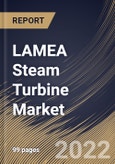Using parts 3-4 of the Rankine cycle, the steam turbine runs on fundamental thermodynamic principles. Depending on the application, superheated steam (or dry saturated steam) exits the burner at high temperatures and high pressure. Steam obtains kinetic energy at the turbine's entrance by flowing through a nozzle, a fixed nozzle in an impulse-type turbine, or the fixed blades in a reaction-type turbine. When the steam emerges from the nozzle, it is travelling quickly in the direction of the turbine rotor's blades. The pressure of the vapor on the blades creates a force that causes them to move.
Steam turbines have advantages over reciprocating engines in steamships, including smaller size, lighter weight, less maintenance, and lower vibration. The most efficient propeller designs are for speeds under 300 RPM, whereas a steam turbine is only effective at speeds in the thousands of RPM. As a result, precise (and therefore expensive) reduction gears are typically needed, even though many early ships through World War I, like Turbinid, had direct drive from the steam turbines to the propellers.
The M-Station expansion project in Jebel Ali's turbine testing has begun under the direction of the Dubai Electricity and Water Authority (DEWA). The largest and newest water desalination and energy-producing facility in the UAE are called M-Station. The enlargement project will cost AED 1.47 billion. Turbine and power generator startup tests also involve coupling them to the grid. The quality and dependability of the units when they are linked to the grid must be ensured by these tests. Testing will continue till the project is finished in Q4 of 2018. The project helps DEWA realize its goal of developing into a leading utility. The growing government initiatives propels the adoption of the steam turbine industry in this region.
The Brazil market dominated the LAMEA Reaction Market by Country in 2021, and would continue to be a dominant market till 2028; thereby, achieving a market value of $121.4 Million by 2028. The Argentina market is experiencing a CAGR of 7.8% during (2022-2028). Additionally, The UAE market would exhibit a CAGR of 7.1% during (2022-2028).
Based on Capacity, the market is segmented into 151 to 300 MW, Up to 150 MW and More than 300 MW. Based on End User, the market is segmented into Power Generation, Oil & Gas, Petrochemical and Others. Based on Technology, the market is segmented into Steam Cycle, Combined Cycle and Cogeneration. Based on Design, the market is segmented into Impulse and Reaction. Based on countries, the market is segmented into Brazil, Argentina, UAE, Saudi Arabia, South Africa, Nigeria, and Rest of LAMEA.
The market research report covers the analysis of key stake holders of the market. Key companies profiled in the report include General Electric (GE) Co., Siemens AG, Toshiba Corporation, Elliott Group (Ebara Corporation), Mitsubishi Heavy Industries Ltd. (Mitsubishi Power, Ltd.), MAN Energy Solutions SE (Volkswagen Group), Fuji Electric Co., Ltd., Kawasaki Heavy Industries, Ltd., Chola Turbo Machinery International Pvt. Ltd., and Turbine Generator Maintenance, Inc.
Scope of the Study
Market Segments Covered in the Report:
By Capacity
- 151 to 300 MW
- Up to 150 MW
- More than 300 MW
By End User
- Power Generation
- Oil & Gas
- Petrochemical
- Others
By Technology
- Steam Cycle
- Combined Cycle
- Cogeneration
By Design
- Impulse
- Reaction
By Country
- Brazil
- Argentina
- UAE
- Saudi Arabia
- South Africa
- Nigeria
- Rest of LAMEA
Key Market Players
List of Companies Profiled in the Report:
- General Electric (GE) Co.
- Siemens AG
- Toshiba Corporation
- Elliott Group (Ebara Corporation)
- Mitsubishi Heavy Industries Ltd. (Mitsubishi Power, Ltd.)
- MAN Energy Solutions SE (Volkswagen Group)
- Fuji Electric Co., Ltd.
- Kawasaki Heavy Industries, Ltd.
- Chola Turbo Machinery International Pvt. Ltd.
- Turbine Generator Maintenance, Inc.
Unique Offerings from the Publisher
- Exhaustive coverage
- The highest number of Market tables and figures
- Subscription-based model available
- Guaranteed best price
- Assured post sales research support with 10% customization free
Table of Contents
Companies Mentioned
- General Electric (GE) Co.
- Siemens AG
- Toshiba Corporation
- Elliott Group (Ebara Corporation)
- Mitsubishi Heavy Industries Ltd. (Mitsubishi Power, Ltd.)
- MAN Energy Solutions SE (Volkswagen Group)
- Fuji Electric Co., Ltd.
- Kawasaki Heavy Industries, Ltd.
- Chola Turbo Machinery International Pvt. Ltd.
- Turbine Generator Maintenance, Inc.








